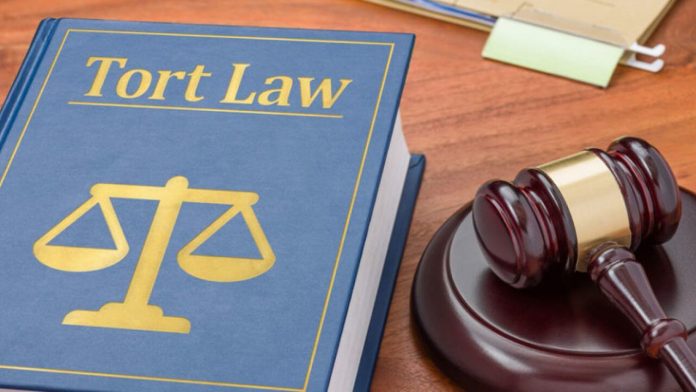This article has been written by Nehal Misra, from Nirma University, Ahmedabad. In this article, she discusses the concept of liability of administration in tort.
Table of Contents
Introduction
Tortious liability arises from an infringement of an obligation that is essentially settled by law: this obligation is to people in general and its infringement is remediable through unliquidated damages. The maxim ‘Ubi Jus Ibi Remedium’ ignited the development of the Law of Torts and the torts submitted by people against one another whereas perceived in custom-based law. According to Roman law, as the state was Sovereign, it was not held liable in torts towards its subjects. It was considered to be a characteristic of Sovereignty that it can’t be sued in its courts without its assent. In England, the Crown believed in tortious liability insusceptibility. During the post-constitutional period, Welfare State logic’s approach prompted the all-overrunning state mediation and diminishing refinement between the public and private capacity of the state. The State was a juristic person acting through its authorities and operators suitable under law. The insusceptibility, however, was limited to traditional State elements such as legislation, equity organization, war, settlement making, and expectation of wrongdoing. The issue of State Liability in Torts has now taken on exceptional importance. The principle of welfare state establishes a link between the individual’s rights and the State’s obligations. As these responsibilities have increased, the expansion of state activities has caused the subjects to have a more notable impact.
Liability of administration in tort
State liability refers to the liability of the state arising from the acts of omission/ commission committed by its servants. It has been governed by written or unwritten laws and is not a static concept. The State’s liability for the tortious acts of its servants, known as the tortious liability of the State, makes it liable, voluntarily or involuntarily, for acts of omission and commission, and puts it before the Court of Law in a claim for unliquidated damages to such acts. This liability is also a branch of the Law of Torts. Law of Torts like various other laws has travelled through the British to this country and is now varied because it is regulated by local laws and constitutional provisions.
English law – In England, the Crown’s outright insusceptibility was acknowledged under precedent-based law. The administration depended on the maxim “the King can’t be blamed under any circumstance”. In 1863, in Tobin v. R., the court observed: “if the Crown were at risk in tort, the rule might have appeared to be insignificant”. In 1947 the Crown Proceeding Act was enacted which put the Government in an indistinguishable position from a private person’s view.
Indian Law – The maxim ‘the king can’t be blamed under any circumstance’ was never acknowledged in India. The government’s absolute insusceptibility was not understood in the Indian legal system before the constitution’s beginning and in numerous cases, the government was subjected to its employees’ convoluted actions. According to Article 294(4) of the Constitution, the liability of the Government of the Union or a Government of the State can arise ‘from some contract or other.’ Article 12 of the Indian Constitution defines the term ‘state’. Under Article 300 (1), the degree of such liability is settled. It states the Union of India or State Government’s liability to be the same as that of Dominion of India and the Provision before the Constitution commenced.
The idea of open responsibility involves an open concern which is imperative. It is a settled law that every single optional power must be sensibly practised in greater open intrigue. In Arvind Dattatreya v. Maharashtra State, the Supreme Court refused the transfer of a police officer because the transfer of the officer was nothing but mala fide exercise of the power to demoralise honest officers who would efficiently discharge the duties of a public office. It was observed that the Government demoralises the officers who discharge the duties honestly and diligently and bring to book the persons indulging in black marketing and contrabanding.
The vicarious liability of the State (for torts) shall be borne by its servants in the exercise of the duties of the State. If the acts performed were necessary to protect life or property, the State would not be held liable. Acts such as judicial or quasi-judicial decisions made in good faith also invite no liability whatsoever. There are specific statutory provisions that are binding on the administrative authorities. However, such protection would not scale up malicious acts. The burden of proving a malicious act would lie on the person who is assaulting the administrative action. The principles of tort law would apply in determining what is a tort and the public servant would also have access to all of the defenses available to the respondent in a tort lawsuit.

Respondeat Superior (Let the principal be liable)
Respondent Superior (Let the master answer) was brought to the premise of the subordinates’ limited economic capacity, and the irresponsible behaviour of superiors such as masters or employers was controlled. This doctrine is based on public policy since it aims to assign the risks usually associated with it to the business. When applying this doctrine, an employer and the master are liable for the negligent commissions or omissions of an employee and the servant which occur during employment. Nevertheless, a relationship between the superior and the subordinate should be established for the liability to fall upon the superiors.
Actions performed by the subordinates during their jobs or agency under an employer or a master’s explicit or implied authority, respectively. There are two requirements of the doctrine:
- A true master-servant and employer-employee relationship.
- The tortious act of a servant and an employee must be one within the scope of his employment. The ‘scope of employment’ refers to the act performed under the express or implied authority of the superiors.
In the case of Automobiles Transport vs. Dewalal and ors, the Rajasthan High Court held that there is always the presumption that a vehicle is driven on the order of the driver, or by his approved agent or servant, and it is up to the appellant to prove that such presumption is unjustified and not confirmed. In the case of Smt. Savita Garg vs. The Director, National Heart Institute, the Supreme Court held that, in the employment contract, the hospital is the principal responsible for the actions of the agent, i.e. one of his doctors, if the court and the complainant are unable to justify that there was no negligence or recklessness on their part and that they were acting with due care and caution.
Qui-Facit per Alium Facit per se (He who acts through another does it himself).
Qui facit per alium facit per se is a fundamental statutory maxim of agency law. It is a maxim frequently stated when discussing the employer’s liability for the employee’s actions as regards vicarious liability. According to this maxim, by employing servants the master is obliged to perform the duties, he is responsible for their actions in the same way as he is responsible for his actions. Indirectly, in the role portrayed by the agent, the concept is in practice or present such that the role performed is seen as the work of the agent himself. Anything that a principal can do for itself can be done through an agent. The exception to that maxim would be personal acts of nature.
In H.E. Nasser Abdulla Hussain vs. Dy. City a tenet of law canonized the dictum: “Qui facit per alium facit per se”. It was held in the case of Ballavdas Agarwala vs. Shri J. C. Chakravarty, that the sections vicariously fastened the responsibility on the masters for the acts of the servants. In K.T.M.S. Mohd. And Anr vs. Union Of India, it was held that the Indian Income-tax Act is a self-contained Code, which is exhaustive of the matters dealt with and its provisions portray an intention to depart from the common rule of Qui facit per alium facit per se.
Compensation by State
The word ‘tort’ (civil wrong- the violation of legal obligation) has been defined in Chambers Dictionary in the following words:- “Tort is any wrong or injury not arising out of contract for which there is a remedy by compensation or damages.” Therefore, tort occurs either from infringement of no contractual obligation or from neglect of civil duty. In other words, a tort is a civil wrong, for which damages are the only remedy. The breach of obligation towards people, in general, is the basic prerequisite for the execution of the tort. Though tort is a civil wrong, it’d be wrong to imply that all civil mistakes are tort.
According to section 70 of the Indian Contract Act, if a person is lawfully doing anything for another person or delivering anything to him the other person enjoys the profit thereof, the latter is obliged to indemnify the former or restore the thing so done or delivered to him. If Section 70’s conditions are met, then the government would be liable to pay compensation for the work performed or services rendered by the state. Section 70 is not based on a subsisting contract between the parties but a quasi-contract or restitution basis. This encourages an individual selling goods or providing services not for free to demand compensation from the person receiving the value of the same. This is a duty that exists on equal grounds and it does not appear to be explicit agreement or contract.
If the agreement with the Government is null and void according to Article 299(1), the party obtaining the advantage under that agreement is obliged to restore it or indemnify the individual from whom it was obtained. Therefore, if a contractor agrees with the government to construct the down payment received and the agreement is found to be void as the conditions of Article 299(1) have not been met, the government may recover the amount advanced to the contractor according to Section 65 of the Indian Contract Act. Section 65 provides that if an agreement is found to be invalid or a contract is invalid, any person who has received any benefit under such agreement or contract is obliged to restore it and compensate the person from whom it was received.
A public servant might be incompetent in the performance of his duty and obtaining compensation from him is difficult. The compensation is more important to the aggrieved person than punishment. The State must also be vicariously held responsible for the wrongdoings of its servants. In Bhim Singh v. the State of J&K, where the petitioner, a member of the Legislative Assembly, was arrested while he was travelling to Srinagar to attend the Legislative Assembly in gross violation of his constitutional rights under Article 21 and Article 22(2) of the Constitution, the court granted the petitioner monetary compensation of Rs. 50,000 by way of exemplary costs. In Lucknow Development Authority v. M.K. Gupta, the Supreme Court observed that when the public servant causes injustice and pain to the common man mala fide, and capricious acts while discharging official duties, it makes the State liable to pay damages from public funds to the aggrieved individual. The State is constitutionally obliged to recover the reimbursement sum from the public servant in question.
Pertinent case laws
Under East India Company, the first judicial definition of State Liability was made in the case of John Stuart, 1775. It was decided for the first time that in cases concerning the dismissal of Government Servants, the Governor-General in Council had no exemption from the jurisdiction of the Court. In Moodaly v. The East India Company, the opinion that the Common law doctrine of sovereign immunity did not apply to India was expressed by the Privy Council.
Pre-Constitution judicial decisions
- Peninsular and Oriental Steam Navigation Company v. Secretary: The rule that was deduced in this case states that the East India Company(State) is excluded from the risks arising due to any action taken in the operation of sovereign capacities. It drew a significantly strong distinction between state sovereign and non-sovereign elements.
- Secretary of State v. Hari Bhanji: The Madras High Court ruled that the invulnerability of the State should be kept to state activities. The decision did not go beyond state actions in the P and O Cases while providing representations of circumstances where the invulnerability was available.
Post-Constitution judicial decisions
- State of Haryana v. Santra: It was held that there was negligence on the state responsibility standards. Henceforth, when the negligence occurred, it added up to behave in the absence of integrity, therefore the State could not use the defense of sovereign resistance. It was also held that negligence by professionals who have an obligation cannot escape the responsibility by asserting the solicitor’s assent guard.
- State of Rajasthan v. Vidyawati: The case dealt with whether the State was at risk for its hireling’s tortious act – The Court held that the State’s liability to its worker’s tortious act within the scope of its business and to work in that capacity was similar to that of some other manager.
- Kasturi Lal v. The State of UP: The decision for this situation was given holding that the act, which offered to ascend to the present claim for damages, was presented throughout its business by the respondent’s representative. That work had a place with a class of sovereign power evacuating any State-related liability.
- In Kesoram Poddar v. Secretary of State for India, the Supreme Court’s decision created a significant state immunity requirement in tort based on the principles of sovereign and non-sovereign duties. It decided that immunity can only be claimed for State action if the act in question was done in the course of exercising sovereign functions.
- In the case of Union of India v. Harbans Singh, it was deduced that damages can’t be recovered when a man was assassinated due to an obligatory military driver’s rash and careless driving of a military truck, because it was a sovereign capacity. In the case of Secretary of State v.Cockraft, the offended party was hurt by the reckless removal of a pile of rock from the military street he was walking over. The lawsuit against the government was not viable in the light of the fact that the military and military street maintenance were a sovereign rather than a private capacity.
Conclusion
All state actions and their instrumentalities must be directed towards the objectives set out in the Constitution. Every government advance should be towards fair conventions, social and financial improvement, and open welfare. Consequently, sovereign insusceptibility as defense should not have been accessible where the State has been engaged in business or private enterprise, nor is it accessible where its officers are guilty of interfering with the life and independence of a lawless citizen. In today’s environment, where the concept of sovereignty itself has undergone a dramatic shift, the teaching of sovereign invulnerability has little value. Sovereignty is, at present, vesting in the general population. Article 21 of the Indian Constitution forbids a State from depriving a person of his life and freedom except in compliance with a process laid down by law. It includes every aspect of life to expand the word ‘life’ which makes life meaningful, complete and living, and even culture, tradition, heritage, and personal freedom. Constitutional laws including directives of Public policy principles place a moral duty on the State for greater enjoyment of human life and dignity. The Constitutional Rights have been guaranteed by the Constitution and are enforceable. Article 32 and Article 226 have not only made the protection of sovereign immunity entirely inapplicable but also overthrown it all together because it can not go along with constitutionally guaranteed freedoms. Because of the full abolition of the sovereign immunity concerning constitutional rights, in particular Article 21, the right to award monetary compensation for violation of law is justified. Governments of the Union and the State should be responsible for tortious actions committed by their workers in the course of employment for breach of Article 21. In the case of Nilabati Behera v. State of Orissa, the Court set out the rules on the State’s responsibility for the payment of compensation and the distinction between the responsibility and the substantive liability for the payment of compensation for the tort committed. If no other possible mode of remedy is open, the Court shall award monetary compensation based on the principle of strict liability for violations of constitutional rights by the State or its employees. Therefore, every government activity has a public dimension in it and thus needs to be fairly informed and motivated by public interest.
References
- http://www.legalservicesindia.com/article/2000/Liability-of-State-In-Contract-And-In-Torts.html#:~:text=The%20first%20important%20case%20involving,Secretary%20of%20State%20for%20India.&text=Hari%20Bhanji%2C%20In%20this%20case,civil%20Courts%20could%20entertain%20them.
- https://acadpubl.eu/hub/2018-120-5/2/179.pdf
- https://shodhganga.inflibnet.ac.in/bitstream/10603/126943/13/13_chapter%205.pdf
LawSikho has created a telegram group for exchanging legal knowledge, referrals and various opportunities. You can click on this link and join:
 Serato DJ Crack 2025Serato DJ PRO Crack
Serato DJ Crack 2025Serato DJ PRO Crack










 Allow notifications
Allow notifications



